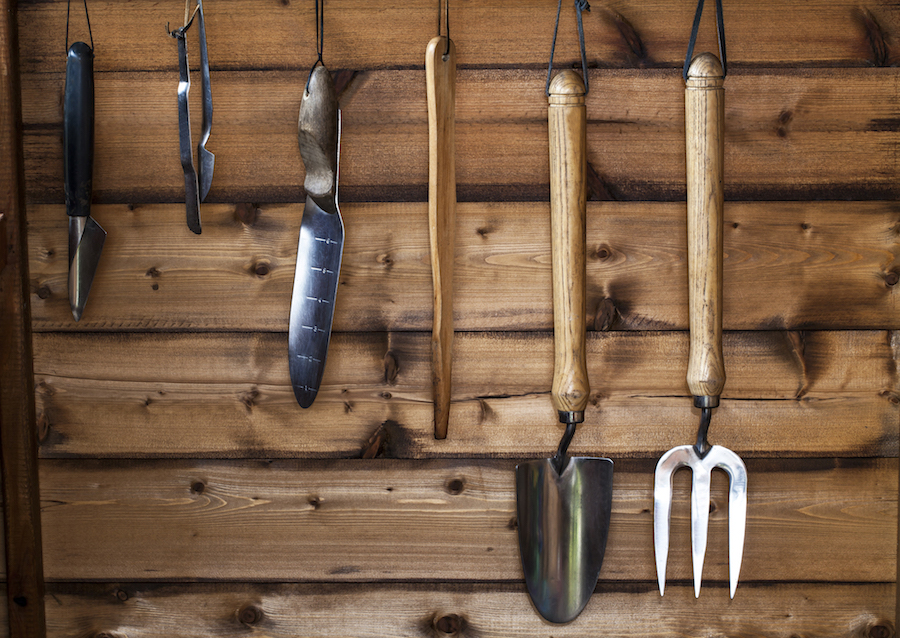Autumn-clean your garden tools and buildings for a head start in spring
Tidy up your growing space to steal a march on spring, with tips from the RHS.
As the days get shorter and temperatures drop, it may seem as though there’s not much left to do in the garden between now and next spring.
But there’s still time to join in the Royal Horticultural Society ‘Grow At Home This Autumn’ campaign, which aims to guide the thousands of gardeners who took up the hobby for the first time during the pandemic through this crucial time of the year.
With the end of the growing season, there are opportunities to improve the soil for next year.
See our soil care guides here:https://t.co/Caa8mkUl8A#GrowAtHome pic.twitter.com/BHalFRDPyr
— The RHS (@The_RHS) October 18, 2020
The final week of the campaign is ‘Autumn Clean Week’ which, as RHS chief horticulturist Guy Barter explains, may not be the most glamorous of jobs but is vital to the health of plants and wildlife in the garden.
“Many people, including seasoned gardeners, don’t realise that an autumn clean and tidy-up in the garden is as important as a spring clean in your home,” says Barter. “By taking care of a few simple jobs now, you can give yourself a head-start for the next growing season, and ensure garden plants have the conditions they need to thrive throughout the winter.”
Barter shares the cleaning and tidying jobs you should be doing now…
Greenhouses and tools

Now’s a good time to clean your glasshouse and its contents
“Get rid of spores and pest eggs by cleansing greenhouses with hot detergent and garden disinfectant, remembering to scrub over concrete floors and replace soiled gravel,” he advises.
Light levels are very low indeed in winter and grubby glass will exclude much light if not washed clean, not forgetting to remove moss and algae from beneath overlapping panes. Caulk any leaks with clear silicone mastic and replace any cracked panes at the same time.
“Compost any unwanted plant material and eradicate weeds, as weeds are reservoirs of pests and diseases,” he adds.
Stainless steel tools merely need a scrape clean, Barter explains, but those made of ordinary steel may rust unless cleaned well and oiled.
Lawnmowers and power tools may also rust in a damp shed unless exposed metal is oiled or paint retouched – you might as well sharpen them and change the oil now that there’s less to do in the garden.

Maintain your mower
Alternatively, take them to a garden machinery workshop for professional sharpening and servicing.
This is also a good time to clean and store plastic pots, seed trays and modules so they are ready for reuse next year.
Winter protection

Give tender plants winter protection with cloches or move them under cover
“Unheated greenhouses are unlikely to exclude frost, so the tenderest plants, aeoniums and tradescantia, say, are best brought indoors to a suitable windowsill or ideally a conservatory,” he advises.
“Pruned and well-wrapped dahlias and canna will survive in a shed or even left in well-drained ground in milder regions, ideally under a 9cm layer of bark mulch.
“Abutilon, fuchsia and other tender shrubs can survive in a greenhouse or sheltered spot if protected by fleece, while hardy plants that don’t appreciate a rainy British winter, garden chrysanthemums for example, will survive well under a cloche.”
However, if you’re thinking about adding an extra layer of protection to your greenhouse, Barter warns: “Insulating greenhouses with bubble wrap cuts out much light and is best kept to the bare minimum – this also reduces plastic waste.”
Houseplants

Keep houseplants glossy
With light levels much lower at this time of year, taking the time to clean accumulated dust from the leaves of houseplants will help them take up all the available light to stay healthy throughout the winter.
Barter suggests taking houseplants outside on a mild rainy day and letting the rain wash them clean, perhaps applying some ‘leaf shine’ when they return indoors.
“Go easy on watering through the winter and hold off on feeding and repotting until the sun comes up again in April,” Barter suggests. Plants that have been sheltering from scorching summer heat in north facing windowsills can return to their winter position in a south facing windowsill.

Give houseplants winter sunlight
Consider a low energy LED growing light in dark homes with limited suitable windowsill space, to give your houseplants a boost during the winter.
Pick off any dead leaves now and take the opportunity to rub out pests, too. However, if your houseplants show symptoms of mealybug, this is virtually incurable and infested plants are best replaced.
For more tips, advice and videos to help you get involved with the RHS Grow At Home campaign, visit rhs.org.uk/growathome.
The Press Association
Latest posts by The Press Association (see all)
- Special stamps to mark 80th anniversary of VE Day - April 24, 2025
- Test your knowledge with our penguin-themed quiz - April 24, 2025
- Prince Louis shows off missing front teeth in new photo to mark seventh birthday - April 23, 2025
- Why does hearing get worse as we get older? - April 23, 2025
- Top scented plants for your garden, from a Kew expert - April 22, 2025



















